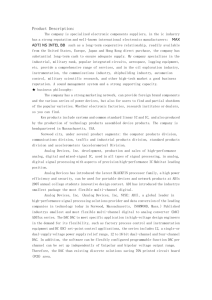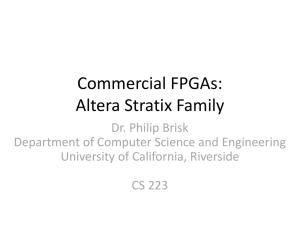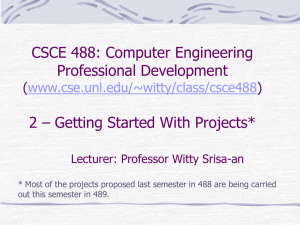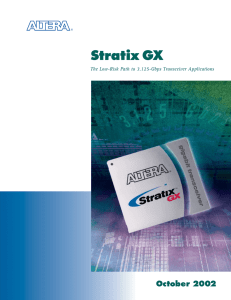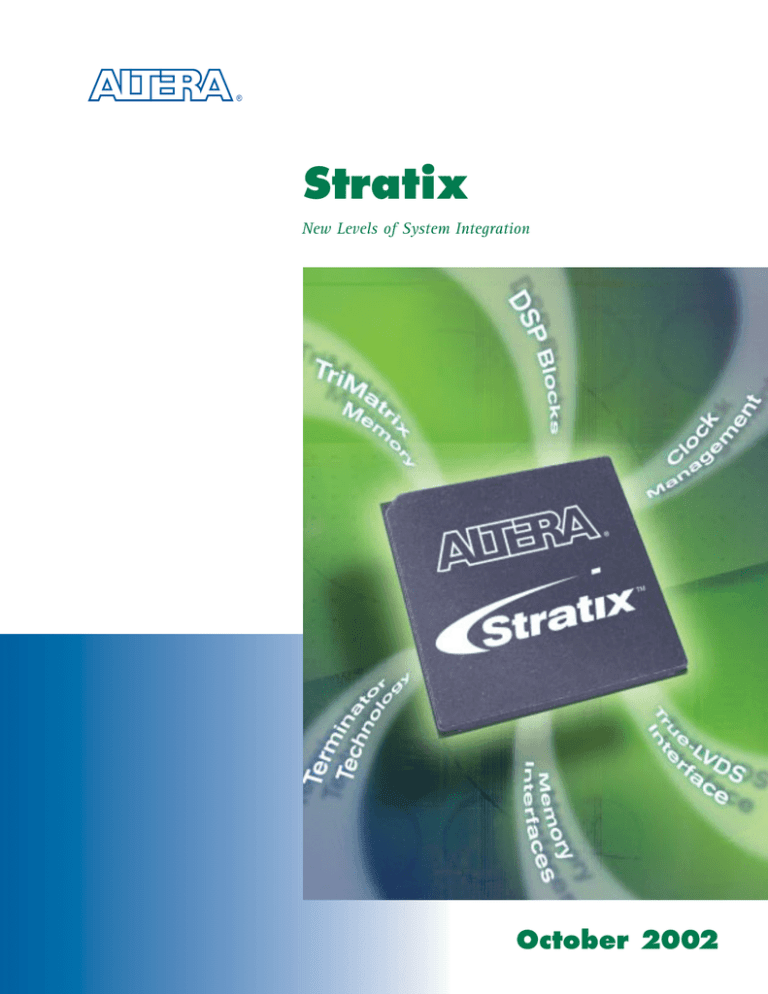
®
Stratix
New Levels of System Integration
October 2002
New Levels of System
Integration
Introducing Stratix™ FPGAs, Altera’s
newest product family that breaks
the performance and density barriers
for high-density programmable logic. The Stratix family is
the first programmable logic device (PLD) family designed
to enable a comprehensive block-based design methodology.
For the first time, in conjunction with the Quartus® II design
software, designers can optimize and lock the performance
of individual design blocks even when blocks are moved or
integrated with other optimized functions.
By eliminating the time-consuming process of performance
re-optimization during system integration, Stratix FPGAs
significantly enhance the time-to-market advantages of highdensity programmable logic. In fact, Stratix devices deliver
on average a 50%—and as high as 100%—improvement in
push-button performance over previous architectures.
Stratix FPGAs are based on a 1.5-V, 0.13-µm, all-layer-copper
SRAM process, with densities ranging from 10,570 to 114,140
logic elements (LEs). The Stratix family offers up to 10 Mbits
of embedded RAM with its TriMatrix™ memory structure.
With three sizes of memory blocks, the TriMatrix memory
structure is optimized for high-memory bandwidth and
large memory storage requirements. Stratix devices include
up to 28 digital signal processing (DSP) blocks that eliminate
the performance bottlenecks in arithmetic applications.
Comprised of multiply and accumulate circuitry, the DSP
blocks provide predictable performance and significant
resource savings for complex applications that require high
data throughput. With up to 12 phase-locked loops (PLLs),
up to 40 system clocks, and support for many single-ended
and differential I/O electrical standards, Stratix devices
bring new levels of system integration for system-on-aprogrammable-chip (SOPC) designs. Table 1 describes some
of the highlights of the Stratix devices, and Table 2 shows
the wide range of features and packages available.
High-Bandwidth Solution
The Stratix device family was specifically designed to address
the increasing bandwidth requirements of high-speed systems.
All aspects of bandwidth are increased: overall memory
bandwidth, arithmetic bandwidth for DSP applications, I/O
bandwidth, and core performance.
Built on the performance-optimized and highly flexible
MultiTrack™ continuous routing structure, Stratix devices
offer dramatically higher core performance than any other
previous architecture. Combined with embedded features
such as TriMatrix memory, DSP blocks, and dedicated highspeed I/O interfaces, Stratix devices deliver the best possible
system integration to meet the requirements of highbandwidth systems.
TriMatrix Memory
Stratix devices feature the TriMatrix memory structure,
made up of three sizes of embedded RAM blocks. TriMatrix
memory includes the 512-bit M512 blocks, the 4-Kbit M4K
blocks, and the 512-Kbit M-RAM blocks, each of which can
be configured to support a wide range of features. Each
embedded RAM block in the TriMatrix memory structure
targets a different class of applications: the M512 blocks
Table 1. Stratix Highlights
Feature
2
Benefit
High-Performance Architecture
New routing structure that provides the basis for block-based design methodology for maximum system
performance with minimum development time
TriMatrix Memory
Three sizes of embedded memory blocks with up to 10 Mbits of RAM, up to 12 terabits per second of memory
bandwidth, and data transfer rates of over 250 MHz
DSP Blocks
Predictable 300-MHz performance for data throughput of up to 2.4 GMACS per DSP block
High-Bandwidth I/O Standards
and High-Speed Interfaces
Support for high-speed I/O standards and high-speed interfaces such as 10-Gigabit Ethernet (XSBI), SFI-4,
POS-PHY Level 4, HyperTransport™, RapidIO™, and UTOPIA Level 4 interfaces at up to 840 Mbps, as well as
support for advanced external memory device interfaces
Clock Management Circuitry
Up to 12 PLLs and up to 40 system clocks with features such as clock switchover, PLL reconfiguration, spreadspectrum clocking, frequency synthesis, and programmable phase and delay shift
Terminator™ Technology
On-chip serial, parallel, and differential termination, and driver impedance matching
Remote System Upgrades
Real-time updates to PLDs from remote locations
Cost Reduction Migration Path
Cost-reduction migration path to HardCopy™ devices supported for high-density Stratix devices
Altera Corporation
Table 2. Stratix Family Overview
Feature
EP1S10
EP1S20
EP1S25
EP1S30
EP1S40
EP1S60
EP1S80
EP1S120
LEs
10,570
18,460
25,660
32,470
41,250
57,120
79,040
114,140
M512 RAM Blocks
(512 bits + parity)
94
194
224
295
384
574
767
1,118
M4K RAM Blocks
(4 Kbits + parity)
60
82
138
171
183
292
364
520
M-RAM Blocks
(512 Kbits + parity)
1
2
2
4
4
6
9
12
10,118,016
Total RAM Bits
920,448
1,669,248
1,944,576
3,317,184
3,423,744
5,215,104
7,427,520
DSP Blocks
6
10
10
12
14
18
22
28
Embedded
Multipliers (1)
48
80
80
96
112
144
176
224
PLLs
Maximum User
I/O Pins
Available Packages
6
6
6
10
12
12
12
12
426
586
706
726
822
1,022
1,238
1,314
956-Pin BGA
956-Pin BGA
672-Pin BallGrid Array
(BGA)
672-Pin BGA 672-Pin BGA
956-Pin BGA 956-Pin BGA
484-Pin
672-Pin
780-Pin
1,020-Pin
1,020-Pin
1,508-Pin
FineLine BGA FineLine BGA FineLine BGA FineLine BGA FineLine BGA FineLine BGA
1,923-Pin
FineLine BGA
484-Pin
672-Pin
780-Pin
1,020-Pin
1,508-Pin
1,508-Pin
1,923-Pin
FineLine BGA® FineLine BGA FineLine BGA FineLine BGA FineLine BGA FineLine BGA FineLine BGA
672-Pin
780-Pin
1,020-Pin
FineLine BGA FineLine BGA FineLine BGA
780-Pin
FineLine BGA
Note: (1) Total number of embedded 9x9 multipliers. To obtain the total number of 18x18 multipliers per device, divide the total number of 9x9 multipliers by 2. To obtain
the total number of 36x36 multipliers per device, divide the total number of 9x9 multipliers by 8.
can be used for small functions such as first-in first-out (FIFO)
applications; the M4K blocks can be used to store incoming
data from multi-channel I/O protocols, and the M-RAM blocks
can be used for storage-intensive applications such as Internet
protocol packet buffering or as program/data memory for
an on-chip Nios® embedded processor. All memory blocks
include extra parity bits for error control, embedded shift
register functionality, mixed-width mode, and mixed-clock
mode support. Additionally, the M4K and M-RAM blocks
support true dual-port mode and byte masking for advanced
write operations.
With up to 10 Mbits of RAM and up to 12 terabits per second
of device memory bandwidth, TriMatrix memory offers the
highest memory-to-logic ratio and the highest memory bandwidth of any PLD family. The TriMatrix memory structure,
shown in Figure 1, makes the Stratix family an ideal choice
for memory-intensive applications.
DSP Blocks
The programmable DSP blocks in Stratix devices are highperformance embedded arithmetic units that are optimized
for applications such as rake receivers, voice over Internet
Altera Corporation
Figure 1. TriMatrix Memory Structure
More Bits for Larger Memory Buffering
More Data Ports for Greater Memory Bandwidth
M512 Blocks
M4K Blocks
M-RAM Blocks
■
512 bits per block
■
4 Kbits per block
■
512 Kbits per block
■
Up to 1,118 blocks
■
Up to 520 blocks
■
Up to 12 blocks
■
IP packet buffering
Applications
■
Rake receiver correlator
■
ATM cell packet
processing
■
Shift register
■
■
System cache
Small FIFO buffers
■
Header/cell storage
■
■
Video frame buffers
Finite impulse response
(FIR) filter delay line
■
Channelized functions
■
Echo canceller data storage
■
Program memory for
processors
■
Processor code storage
3
protocol (VoIP) gateways, orthogonal frequency division
multiplexing (OFDM) transceivers, image processing applications, and multimedia entertainment systems. Flexible,
efficient, and valuable for a variety of applications that
require high data throughput, these DSP blocks can implement
a variety of typical DSP functions, such as finite impulse
response (FIR) filters, fast Fourier transform (FFT) functions,
correlators, and encryption/decryption functions, and are
ideal for the wireless communication, telecommunication,
video, and image processing markets.
Figure 2. DSP Block Architecture
Optional
Input
Registers
Optional
Pipeline
Registers
Optional
Output
Registers
The DSP blocks eliminate performance bottlenecks in complex
arithmetic applications, provide predictable and reliable
performance, and save resources without compromising
performance. This makes DSP blocks ideal for implementing computationally complex systems while providing high
data throughput at the same time.
Stratix DSP blocks consist of hardware multipliers, adders,
subtractors, accumulators, and pipeline registers. DSP blocks
in Stratix devices can run at 300 MHz to provide data
throughput performance of up to 2.4 GMACS per DSP block.
With up to 28 DSP blocks, Stratix devices can provide a combined throughput that is more than 10 times the data throughput available from leading digital signal processors today.
Summation Unit
Table 3. DSP Block Features
Programmable Element
Because the Stratix DSP blocks are implemented with
dedicated circuitry as shown in Figure 2, they can offer
designers optimal performance. Table 3 highlights the
features of Stratix DSP blocks.
Multiplier
High-Bandwidth I/O Standards & HighSpeed Interfaces
Adder/Subtractor/
Accumulator
Stratix devices support a variety of single-ended and
differential I/O standards to interface easily with backplanes,
host processors, buses, memory devices, and 3D graphics
controllers. Stratix devices offer designers an aggregate
device bandwidth of up to 600 Gbps and access to up to
116 high-speed differential I/O channels. Each of these I/O
channels includes dedicated serializer/deserializer (SERDES)
circuitry for high-speed interface standards as shown in
Table 4. This support for high-speed I/O interfaces and
high-bandwidth protocols makes Stratix devices an ideal
solution for complete system integration.
Differential I/O Standard Support
Stratix devices offer the True-LVDS™ circuitry to support
the LVDS, LVPECL, PCML, and HyperTransport differential
I/O standards as well as differential HSTL and SSTL. The
Stratix device family has up to 116 high-speed input and
4
Adder/Subtractor/
Accumulator
Multiplier
Benefit
■
9x9, 18x18, and 36x36 multiplication
■
Floating-point arithmetic
■
Signed and unsigned operation
■
Full precision in all modes
■
Optional shift register chain on inputs
■
Dynamic switching between adder and
subtractor
■
9-bit, 18-bit, or 36-bit operation for
adder and subtractor
■
52-bit accumulator
■
Signed and unsigned operation
Summation Unit
■
Summation of up to four products in
one clock cycle
Complex Shift Function
■
Barrel shifter, cross-bar switch, and
encryption
116 output differential I/O channels with up to 80 channels
optimized for 840-Mbps operation.
Single-Ended I/O Standard Support
To interface with other devices on a board, Stratix devices
support single-ended I/O standards such as LVTTL,
LVCMOS, SSTL, HSTL, GTL, GTL+, PCI-X, AGP, and CTT.
Devices using single-ended I/O standards provide more
current drive capacity than differential I/O standards, and
Altera Corporation
Table 4. Stratix I/O Standard & Interface Support
Feature
Single-Ended I/O Standards
Differential I/O Standards
External Memory Interfaces
Electrical Standards
LVTTL, LVCMOS, SSTL, HSTL,
PCI-X, CTT, AGP, GTL+
LVDS, LVPECL, HyperTransport, PCML
SSTL-2, SSTL-3, SSTL-18, HSTL Class I
& II, Differential SSTL, Differential HSTL
Dedicated Circuitry
■
True-LVDS circuitry
Dedicated DDR circuitry
■
Related Altera® Intellectual
Property (IP) Cores &
Reference Designs
Terminator technology
on-chip termination
PCI compliant
■
Dedicated SERDES circuitry
■
Dedicated DQS circuit
■
Differential I/O buffers
■
DDR timing circuit
■
Data realignment
■
Dedicated I/O registers
■
PCI-X
■
POS-PHY Level 4
■
DDR SDRAM controller
■
32-/64-Bit PCI
■
UTOPIA Level 4
■
■
CSIX
■
Flexbus Level 4
Single data rate (SDR) SDRAM
controller
■
Direct memory access
(DMA) controller
■
HyperTransport
■
DDR FCRAM controller
■
RapidIO
■
■
Universal serial bus (USB)
controller
Quad data rate (QDR) SRAM
controller
■
ZBT RAM controller
they are necessary when working with advanced memory
devices such as double data rate (DDR) SDRAM and zerobus turnaround (ZBT) SRAM devices.
Figure 3. Stratix On-Board High-Speed Interface Support
To Host Processor
XSBI, SFI-4,
UTOPIA IV
High-Speed Interface Support
Altera continues its industry-leading high-speed differential
I/O interface support with Stratix devices. Stratix devices
support a wide array of high-speed interface standards,
including the 10-Gigabit Ethernet (XSBI), SFI-4, POS-PHY
Level 4 (SPI-4 Phase 2), HyperTransport, RapidIO, and
UTOPIA IV standards. Designers can use Altera intellectual
property (IP) cores to bridge between high-speed interfaces
through the Atlantic™ local interface. In addition, Stratix
devices can support up to four high-bandwidth interfaces in
one device for an unparalleled bridging solution, as shown
in Figure 3.
High-Speed External Memory Interface Support
In addition to the on-chip TriMatrix memory, Stratix devices
address increasing memory bandwidth requirements by
providing customers with additional off-chip data storage
that supports external memory interfaces. Designers can
easily connect Stratix devices to a wide range of the latest
SRAM and DRAM memory devices from leading vendors.
Using Stratix device features and customizable IP, designers
can integrate high-density memory devices into complex
system designs without reducing data access performance
or increasing development time. Stratix devices address a
wide variety of cutting-edge memory interfaces, as
summarized in Table 5.
Altera Corporation
RapidIO,
HyperTransport
ASSP
®
Network
Processing
Backplane
POS-PHY L4
To Backplane
Table 5. Stratix External Memory Interface Support
External Memory
Device
Maximum Data
Transfer Rate
Memory Clock Speed
SDR SDRAM
200 Mbps
200 MHz
DDR SDRAM
400 Mbps
200 MHz
DDR FCRAM
400 Mbps
200 MHz
ZBT SRAM
200 Mbps
200 MHz
QDR SRAM
668 Mbps
167 MHz
QDRII SRAM
668 Mbps
167 MHz
5
High-Performance
Architecture
Figure 4. Stratix Clock Management Circuitry
Built on an innovative architecture, the Stratix devices allow
designers to take advantage of the performance capabilities
of dedicated silicon blocks while preserving overall design
flexibility. This architecture gives designers the solution
they need to reach their designs’ performance and bandwidth targets.
Stratix Architectural Advances
The Stratix device family is based on a new architecture,
built from the ground up, to power complex designs to new
levels of system integration. In concert with the LogicLock™
design methodology, Stratix devices simplify the difficult
process of design integration, providing the basis upon which
block-based designs can be developed and optimized for
maximum performance.
This new high-performance architecture is based on the
MultiTrack interconnect with DirectDrive™ technology. The
MultiTrack interconnect consists of continuous, performanceoptimized routing lines of different lengths used for interand intra-design block connectivity. DirectDrive technology
is a proprietary, deterministic routing technology that
ensures identical routing resource usage for any function,
regardless of its placement within the device. These two new
architectural advances simplify the system integration stage
of block-based design by eliminating the time-consuming
system re-optimization cycles that typically follow design
changes and additions.
Terminator Technology
Terminator technology in Stratix devices is an on-chip
termination resistor technology that supports on-chip serial,
parallel, and differential termination and driver impedance
matching. Driver impedance matching is essential for reducing
reflections and improving signal integrity (as shown in
Figure 5) for maximum system performance.
Figure 5. Terminator Technology Improves Signal Integrity
Clock Management Circuitry
With up to 12 PLLs and up to 40 system clocks per device,
Stratix devices are built to function as the central clock
manager to meet your system timing challenges. These devices
are the first PLDs to offer the on-chip PLL features for
system-level clocking management previously found only
in high-end discrete PLL devices.
Stratix devices offer two types of PLLs: enhanced PLLs that
support advanced features such as external feedback, clock
switchover, PLL reconfiguration, spread-spectrum clocking,
and programmable bandwidth, and fast PLLs that are
optimized for high-speed differential I/O interfaces and can
be used for general-purpose clocking. Figure 4 illustrates
the features of Stratix PLLs.
6
Signal Reflection
Improved
Signal Integrity
Without Termination
With Terminator Technology
Terminator on-chip termination also reduces board space
usage and simplifies board layout by minimizing the
number of external resistors required on the PCB when
compared to other termination techniques, as Figure 6
illustrates. To provide constant calibration of the internal
resistor values, Terminator technology utilizes two external
precision resistors per I/O bank and monitors the value of
these resistors. The termination resistors can then compensate
for process, temperature, and voltage variations.
Altera Corporation
Figure 6. Terminator Technology Simplifies Board Layout
Many External
Termination Resistors
Only Two Reference Resistors
Needed per I/O Bank
Logic
Device
®
External Termination
Terminator Technology
Remote System Upgrades
Increased competition and shrinking windows of opportunity require your product to be the best in the market. While
using PLDs gets your designs to market faster, using the
remote system upgrade capability in Stratix devices can keep
your products on technology’s cutting edge. Remote system
upgrades can be transmitted through any communi-cations
network to keep your SOPC designs ahead of the competition.
Stratix devices provide both enhanced design flexibility
and an extended life cycle, as shown in Figure 7.
Altera SOPC Solutions
Altera offers a set of solutions for creating complete
systems on Stratix devices, including the Quartus II design
software, optimized IP, the Nios embedded processor, and
customer training.
Quartus II Design Software Simplifies
Design
The Quartus II design software provides the most comprehensive environment available for SOPC design. This is
because the Quartus II software contains a suite of programmable logic design and verification tools, an integrated
embedded software development environment, and integration to third-party EDA software. The Quartus II software
allows designers to implement advanced device features to
integrate IP megafunctions easily.
Table 6 shows the highlights of the Quartus II design software
version 2.1
Table 6. Quartus II Design Software Version 2.1 Highlights
Feature
Uses block-based design and optimization
capabilities to shorten design and verification cycles and enable team-based design.
PowerFit™ Placeand-Route
Improves productivity by intelligently
optimizing designs based on user’s timing
specifications and delivering the fastest
compile times in the industry.
Timing Closure Flow
Includes timing closure floorplan editor to
display physical timing estimates between
nodes in real time, ability to make powerful
path-based assignments on critical paths to
remove performance bottlenecks easily,
netlist optimization features, and
incremental, block-based placement.
SignalProbe™ InSystem Verification
Allows incremental routing of internal nodes
to unused or reserved pins for analysis with
an external scope or logic analyzer.
SignalTap® II
Embedded Logic
Analyzer
Enables designers to capture internal signal
values in-system and running at system
speeds without external probes and without
changing user design files.
NativeLink®
Integration
Seamless integration of Quartus II software
with third-party EDA synthesis and verification software.
SOPC Builder
Integration
Integrates SOPC Builder automated system
definition and integration tool.
Figure 7. Remote System Upgrade Benefits
Revenue
Get to Market Faster
Stay in Market Longer
Remote-Upgrade-Enabled
System
PLD-Based System
Expanded
Life Cycle
ASIC-Based System
Time
Altera Corporation
Benefit
LogicLock Design
Methodology
7
Intellectual Property
Altera and Altera Megafunction Partners Program (AMPPSM)
partners offer over 60 off-the-shelf IP megafunctions
optimized for Altera Stratix devices. Designers can easily
implement these parameterized blocks of IP, reducing design
and test time. Megafunctions provide total solutions by
targeting specific application areas, providing optimized
performance and system reusability, and significantly
reducing a product’s time-to-market.
Nios Embedded Processor Solutions
The Nios embedded processors solutions allow designers to
integrate embedded processors for complete SOPC designs on
Stratix devices. The Nios soft core embedded processor has
been optimized for the advanced architectural features of
the Stratix device family to deliver increased performance
and capabilities. With the Altera SOPC Builder, designers
select from the wide array of IP components, customize
them for the particular application, and connect them—
automatically generating hardware, software and simulation
models for the custom implementation. Stratix devices and
the Nios embedded processor solutions simplify the design
process and accelerate time-to-market.
Customer Training
For customers interesting in learning more about designing
quickly and efficiently with Stratix devices, Altera has
launched a unique instructor-led modular training series.
This Stratix device-specific series consists of individual training modules that can be arranged to create custom courses
tailored to customer needs and based on their existing
experience. Altera also offers three one-day courses that
cover all modules.
Contact Altera Today
The Stratix device family provides the ideal solution for
your high-bandwidth, high-performance design needs. Visit
the Altera web site today to learn more about the Stratix
device family and its high bandwidth solutions at
www.altera.com/stratix.
®
The Programmable Solutions Company ®
Altera Offices
Altera Corporation
101 Innovation Drive
San Jose, CA 95134
Tel: (408) 544-7000
www.altera.com
Altera U.K., Ltd.
Holmers Farm Way
High Wycombe,
Buckinghamshire
HP12 4XF
United Kingdom
Tel: (44) 1 494 602 000
Altera Japan, Ltd.
Shinjuku i-Land Tower 32F
6-5-1, Nishi-Shinjuku
Shinjuku-ku, Tokyo 163-1332
Japan
Tel: (81) 3 3340 9480
www.altera.co.jp
Altera International, Ltd.
2102 Tower 6
The Gateway, Harbour City
9 Canton Road
Tsimshatsui, Kowloon
Hong Kong
Tel: (852) 2945-7000
Copyright © 2002 Altera Corporation. All rights reserved. Altera, The Programmable Solutions Company, the stylized Altera logo, specific device designations, and all other words and logos
that are identified as trademarks and/or service marks are, unless noted otherwise, the trademarks and service marks of Altera Corporation in the U.S. and other countries. HyperTransport
and RapidIO are trademarks of their respective owners and may be registered in certain jurisdictions. Altera products are protected under numerous U.S. and foreign patents and pending
applications, maskwork rights, and copyrights.
GB-STRATIX-2.0

